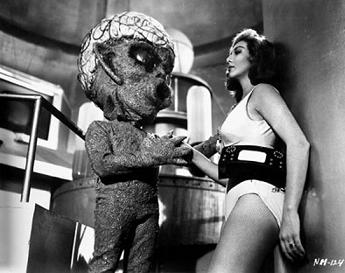
“I knew Sterling when he was an Aztec pimp”: the SF writer and Fine Young Ballardian Chris Nakashima-Brown, quoting William Gibson talking about Bruce Sterling. Neither of us could parse Gibson’s one-liner, but it had a certain corkscrew logic to it.
Nakashima-Brown and I were in Mexico City last week, along with Sterling, Christopher Priest, M. John Harrison, and Linda Nagata, for “Parallel Worlds,” part of the venerable Festival de Mexico en el Centro Historico. (I gave a lecture titled “Myths of the Next Five Minutes: A Science Fiction of the Future Present,” which used Ballard’s 1974 introduction to the French edition of Crash as a jumping-off point for some speculations on the cultural role, and literary possibilities, of science fiction after the extinction of the future and the obsolescence of utopia.)
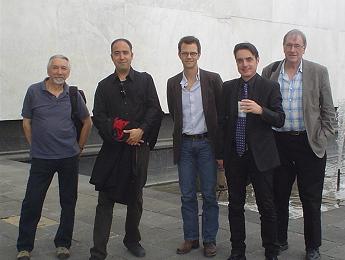
Mexico City is the capital of the 21st century, to borrow the subtitle of David Lida’s First Stop in the New World, an addictively readable, pants-splittingly hilarious dérive through the world’s second most populous city (Tokyo is the first) and undeniably one of its most vibrant. Lida’s book is an intellectual luge ride through The Labyrinth of Solitude; a videogame for virtual flaneurs, based on Benjamin’s Arcades Project but relocated to the D.F. (Distrito Federal), with a nonstop Mex-tec soundtrack.
Lida was gracious enough to take me on a taco crawl through the streets of the D.F., where we gorged ourselves on tacos of, er, mixed grille (slaughterhouse sweepings, by any other name, but delicious nonetheless—I loved the tacquero‘s droll touch of plopping a fist-sized pig’s heart amid the scraps of mystery meat on the grille, to be cleavered into bite-sized pieces as needed); fried tacos with a schmear of pig’s brains; tacos de carnitas (braised pork, so meltingly delicious it’s almost erotic); tacos plump with sweetbreads; and of course the signature Mexico City taco, tacos el pastor, which chilangos (roughly, Mexico City homies) heatedly insist is a local invention, to the consternation of their countrymen in nearby Puebla, who just as heatedly claim that distinction. One thing is sure: This sublime concoction—pork spiced and tinted a traffic-cone orange by the liberal use of Annatto, then roasted on an upright spit and shaved into a corn tortilla, where the tacquero tops it off with pineapple, onions, and cilantro—draws its inspiration from the shawarma introduced to Mexican gastronomy by Lebanese immigrants.
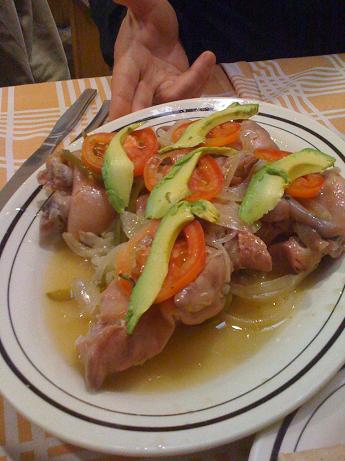
D.F. cuisine, like the self-assembling megasprawl of the city itself, is a mash-up of traditions and trends, ideas and images, riffs and themes: pre-Columbian, or at least (as Lida noted) imagined pre-Columbian, elements (such as the cactus grubs, gusanos de maguey, and red-ant larvae, escamoles, that I ate for lunch at one white-tablecloth restaurant); the colonial legacy (the Spanish influences of the conquistadors, always and everywhere, but also the gallic shadow cast by the French Intervention of 1862-67); and immigrant strains (Lebanese influences, of course, but also such improbable imports as the pasty, a meat pie brought to Hidalgo in the 19th century by Cornish miners, which lives on in the form of tinga- or mole-slathered pastes—an inimitably Mexican dish, in the minds of the locals).
Walking with Chris through what our urbane host, the Mexican writer and translator Mauricio Montiel Figueiras, described as a yuppie neighborhood, I was fascinated by Mexico City’s gene-splice of first-world, cosmopolitan sophistication—easily the equal of most American big cities, the D.F. thumps with club life, media buzz, and boho creativity—and third-world squalor, corruption, and crime, both petty and spectacular. Gabacho tourists ask, inevitably, about the arcane system for determining which taxis are safe and which will speed you to the inevitable hour of reckoning with a kidnapper. Eating tacos at night, I was accosted by a cringing teenaged beggar straight out of Mayhew’s nightmare snapshots of the Victorian underworld, his matted hair and caked skin so dark with grime he looked like a shadow come to life (or, at least, undeath), peering at me with half-dead eyes. In First Stop in the New World, Lida notes that the world’s richest man lives in Mexico City, as do millions of the planet’s most wretchedly poor.
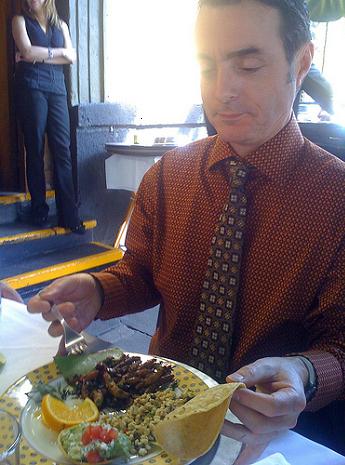
There is something here of Gibson’s sprawl, and of the “mongrel metropolis” of Blade Runner‘s panethnic, polyglot street rabble. Yet there is something as ancient, here, as the Aztec pyramids that still wait, out beyond the city’s metastasizing edge, for the wink of the obsidian knife and the splash of blood on their thirsty stones. An archaic futurism. A sense that this place has Always Already been postmodern, a re-mix of cultures and empires and ages, and thus is well-prepared for the fluid dynamics of chaos culture, where the only steady state is nonstop turbulence. Mexico City, capital of the 21st century.
Tellingly, the Mexican philosopher Jose Vasconcelos countered racist disdain for Mexico’s racially heterogenous culture with what Donna Haraway might call an “ironic myth”—his sci-fi vision, in 1925, of La Raza Cosmica, a “Cosmic Race” ripped and remixed from the genetic riffs reverberating through Mexican culture (the Indian, the Caucasian, and the Black). Parrying social Darwinian theories of pureblooded nordic superiority with a 21st-century ciencia ficcion about a panethic superrace whose racial hybridity is its strength, Vasconcelos dreamed of a “fifth race” that would build a new civilization, Universopolis. Not a utopia so much as a heterotopia. I’ve never seen renderings of it, but in the Richard Powers pulp landscapes of my imagination, Universopolis is a cross between Hugh Ferris’s gothic megastructures and, say, the Aztec pyramid of the Sun and Moon. (Wait—isn’t that what the Tyrell pyramid, in Blade Runner, is?)
There is a glimmer, in Vasconcelos’s vision of Things to Come, of all those post-structuralist hymns to hybridity, partiality, contingency, and of the feminist worship of the post-colonial cyborg as a household deity. (Was Frida Kahlo, patron saint of gabacho feministas, a cyborg? Did the Virgin of Guadalupe embark on a space odyssey, across the wounded galaxies, from El Planeta de las Mujeres Invasoras (Planet Of The Female Invaders) to her assignation with Juan Diego? And what about that escapee from The X-Files, Santa Muerte?) Ineluctably, El Presidente of Universopolis will be the lucha libre (masked wrestling) star Tinieblas. In Lourdes Grobet: Lucha Libre, we find Tinieblas’s official backstory: “He is the prototype of the Mexican science fiction superhero: a survivor of a superior pre-Hispanic race that cultivated physical, mental and intellectual powers; a civilization bonded by the magical energy emanating from the universe. His name is Tinieblas…a direct descendant of beings from another world, who, mistaken for gods, arrived with our forefathers. One of their vessels that reached the Earth, a pyramid-shaped spacecraft, was covered by boulders somewhere in the southeastern jungle…”

Tinieblas, with his furry-faced dwarf sidekick. From Masked Superstars of Mexican Wrestling: The photographs of Lourdes Grobet.
I imagine Presidente Tinieblas in full Aztec Pimp drag: a couture version of Burroughsian cut-up that accessorizes the Saville Row bespoke suit with pre-Columbian body modification (nose plugs, ear piercings, jade-inlaid dental grilles) and tops the whole enchilada off with a lucha mask and gold-lamé wrestler’s boots. Seated regally atop a high-tech skyscraper that is equal parts Teotihuacan and Abu Dhabi, El Presidente gazes out at the multitude thronging the plaza at his feet: Aztec mummies, mad scientists, evil midgets from space, scantily clad vampire women, a Frankenstein monster with a goatee, and of course masked wrestlers beyond count, some of indeterminate gender. With a languid wave of his bejeweled hand and an evil gleam in his eye, he dispatches El Santo, Blue Demon, and Mil Mascaras on a covert mission through the time portal, into the past. “Bring me the head of Mel Gibson!,” he bellows, and the crowd goes wild.
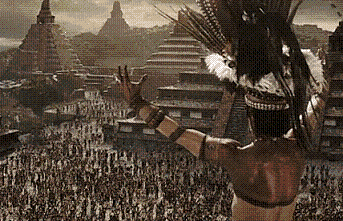
Mexico City, in fact Mexican culture in toto, is all about hybridity, partiality, and contingency; about rejoicing in the recombinant, and the brash, exuberant spirit of bricolage that suffuses the colonia (ghetto) culture and is trickling up, into the boho vanguard—rasquache, the hacker-ish spit-and-duct tape improvisation one sees everywhere in Mexico, but especially in the shantytowns, where in Tijuana for example, American garage doors are sold as “walls” (the better to make houses out of) and people pry hunks off the million-dollar border fence—literally appropriating pieces of Fortess America’s Maginot line—and incorporate them into their shacks.
For the well-educated, well-traveled Mexicans rolling their eyes at the crypto-colonialist subtext of this freely improvised post, right about now, let me be clear: This isn’t to romanticize Mexico’s own taxonomy of racism (expressed, most notably, in 18th century casta paintings), which Lida anatomizes in painful detail, nor to glamorize the abject poverty, brutality, and pestilential filth of the colonias. But there’s an electric vitality, the unmistakable crackle of a cultural power on the rise, in Mexico City, and even in narco-gang killing fields like Tijuana, where the San Diego architect Teddy Cruz goes for inspiration.
“Where others saw poverty and decay, he saw the seeds of a vibrant social and architectural model, one that could be harnessed to invigorate numbingly uniform suburban communities just across the border [in San Diego]…Developers in Tijuana would build entire neighborhoods of generic 400-square-foot houses, ‘miniature versions of suburban America,’ Mr. Cruz said in an interview. ‘What I noticed is how quickly these developments were retrofitted by the tenants.’ Informal businesses like mechanics’ shops and taco stands would quickly sprout up on the front lawns and between the houses, transforming them into highly layered spaces.'”(The New York Times.)
In my magical-urbanist fantasies, Lebbeus Woods goes nortec. Piranesi jettisons his panoptical paranoia, gets over his carceral hangover, and reinvents the colonia. Archigram tries its hand at Mexican SF. Constant designs a retirement home for crossdressing luchadores. The “liquid” architect Greg Lynn and his Deleuzean bootboys make a run for the border, and never return.
“In a patchwork of plywood hovels, auto repair shops and hasty additions, Mr. Cruz has found a humane model for rethinking America’s suburbs. He has been pushing that vision as an antidote to the gated communities that have sprouted from Southern California to Israel to mainland China in recent years. […] In Mr. Cruz’s view, such projects are a sterile and soulless counterpoint to Tijuana’s labyrinthine ghettos, cobbled from the residue of a wealthier echelon. As Tijuana has expanded into the hilly terrain to the east, squatters have fashioned an elaborate system of retaining walls out of used tires packed with earth. The houses jostling on the incline are constructed out of concrete blocks, sheets of corrugated metal, used garage doors and discarded packing crates, much of it brought down by local contractors and wholesalers from across the border. Once such a settlement is completed, it is protected from demolition under Mexican law, and the government is eventually obliged to provide plumbing, electricity and roads to serve it. In Mr. Cruz’s view, the process is in some ways a far more flexible and democratic form of urban development than is the norm elsewhere. […] It’s not that he romanticizes poverty: he recognizes the filth and clutter, the lack of light and air, that were the main targets of Modernism nearly a century ago. But by approaching Tijuana’s shantytowns with an open mind, he can extract a viable strategy for development that is rooted in local traditions.”(The New York Times.)
There’s talk, online, of shantytowns springing up across America, and of belt-tightening suburbanites and even urbanites tilling their own backyards and in some cases raising their own livestock, rediscovering the world before agribusiness. There’s talk, too, of re-thinking consumer culture and the vicious cycle of planned obsolescence and conspicuous consumption, the American gospel of infinite resources and the inexhaustible landfill. There are fever dreams of going hyperlocal in the most profound economic, agricultural, and maybe even political senses. (There are dark mutterings about the obsolescence of capitalism itself; in some corners of the ideological map, the dread word “socialism” has even been mentioned, in all seriousness.) There’s talk of growing your own, embracing the “Maker mindset” of DIY culture. On our tumbleweed frontiers, where the scrub is reclaiming the crabgrass of exurbia’s sprawl and coyotes obligingly help thin the growing population of abandoned pets, it may be time to translate rasquache strategies of appropriation and ad hoc-ism, re-purposing and re-skilling, into the American vernacular, crosswiring them with the Edisonian tradition of basement tinkering and the hacker ethos of cracking and open-sourcing. As Mike Davis puts it in his essay of the same name, it’s time to start learning from Tijuana:
Tijuana’s bootstrap brand of urbanism ADOBE LA points out is antipodal to the monolithic utopias advocated by Le Corbusier and other modernists, where the city is the outcome of a single magisterial vision. In the Do-It-Yourself City, bricolage supplants master-planning, and urban design becomes a kind of art brut, generated by populist building practices. If only by default, the masses become the city’s true auteurs, and architecture is not so much transcended as retranslated through its dynamic vernacular context.
The boho romanticism of another gabacho Marxist? Perhaps. But as we teeter at the top of the rickety, ominously creaking Coney Island rollercoaster of our historical moment, gut clenching before the inevitable sickening plunge into yet another economic trough, we might want to consider that our neighbors to the south have been here before, and before that, and before that. They earned their sea legs, long ago, on the slippery deck of a culture that never stops pitching and rolling, and just might have something to teach us, if we’re smart enough to start listening.
It’s late. I’m walking down the street in that yuppie neighborhood with Chris and Mauricio. I sidestep an ankle-snapping pothole in the road. On the wind, I catch a whiff of Mexico City: the ever-present smell of exhaust from some of the D.F.’s four million cars (by Lida’s reckoning), a hint of vegetable decay that translates to my gabacho nose as jungle rot, the smell of something sizzling in oil, and of concrete dust, and somewhere down in the bass register, the unmistakable reek of raw sewage. I ask Mauricio if the American perception of Mexico as a nation only recently arrived from the Planet of Slums is racist myth or everyday reality or a bit of both? How valid is the Cancun fratboy’s perception of the place as a tragi-comic post-Third World-but-not-quite-ready-for-prime-time country where the phones and the power and mass transportation and the government and the cops may work, on a good day, or then again may not? He smiles. “It’s a miracle this city works at all,” he says. But, against all odds, it does.


